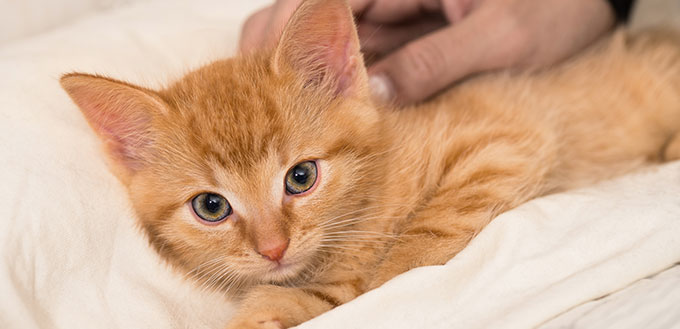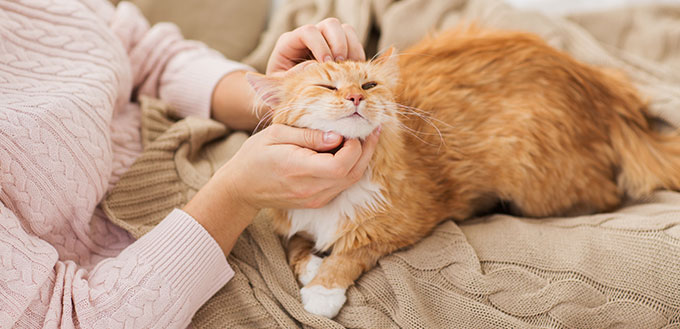Massages come in all shapes and sizes, and I love all of them. If you like massages like I do, you may wonder if your cat would also enjoy getting a massage. Whether a relaxing cat massage or a therapeutic cat massage, there are a lot of reasons you may want to try out massaging as an activity for you and your cat. Some cats will love it, but remember that some cats will really hate it, so start carefully and gently.
The Benefits of Cat Massage
Many experts may recommend to you that you massage your cat, but why is it such a good idea? Do animals get as much from massages as humans do, or is it a waste of your time? Well, the truth is there are many benefits, if you can get your cat sit still long enough to try it. The advantages of massaging your cat include:
- Building the special bond of affection and trust between you and your cat.
- Stress relief for anxious or nervous cats as dopamine and serotonin are released, which are known as ‘feel-good’ hormones.
- Improving their coat.
- Reduction of aggressive behavior due to a stronger bond of trust and happier outlook.
- The opportunity for medical checks for wounds and lumps, or parasites and ticks.
- Relieving pain for cats that suffer from arthritis or other joint issues.
- Improving blood circulation and lymph systems.
- Eliminating toxins.
- Relieving other medical issues, such as diabetes, inflammatory bowel disease, and kidney disease.
With all these benefits, it can’t be surprising that most experts will happily recommend that you at least give it a go. There are, however, times that massage may not be advised. These are few and far between, but it is important not to add to any health problems your cat may be suffering from. Two such examples include:
- If they are suffering from cancer
- If they have a fever
It is always worth discussing with your vet or another professional expert before taking on any new treatments for your cat. They can advise you how best to help with any specific conditions your cat has, and may even be able to advise you on technique. But, for the most part, massaging your cat is a safe and potentially hugely beneficial activity.

How Do You Massage A Cat?
Ultimately, a gentle massage is very unlikely to do any harm, so there is no reason not to at least try it! Just be careful that you are not using too much pressure, or stressing any joints. If you want to explore the world of cat massages, here are some cat massage techniques you may want to experiment with:
- Start in a familiar spot and stroke your cat slowly. For example, if they like to be stroked on their head, start here and stroke them in the exact same way you normally do.
- Gradually adjust your technique to use even pressure using your full palm or even whole hand. Move to stroking them the length of their body, from head to tail.
- Move to their shoulders using circular motions. A good idea is to put each hand either side of their upper body and rub gently downwards, as well as in circular motions.
- You can then move down their back, continuing gentle pressure and circular motions. You must be particularly careful about moving to their hind legs and lower back as these can be more sensitive. If you suspect that they are tensing up, stop and stay at their upper back and shoulders.
- Similarly, you may want to move to massage their belly, but must be prepared to stop if they don’t seem keen. After gently rolling them over, hold them in place with one hand while rubbing their belly and chest with circular motions with the other hand.
- Last, but not least, you can massage their tail. Start at the base, rubbing and gently squeezing their tail and moving up towards the tip. Tails are extremely sensitive, which is why you should leave them to last. Your cat will need to be very relaxed to let you touch their tail.
Tips for Massaging Your Cat
Massaging your cat is not always easy, but it is worth it when your cat is amenable. To help you do the best job that you can so that your cat will get the most out of it, here are some helpful tips:
- Wait for the right time
If your cat is too hungry, too tired, anxious or grumpy, they won’t feel like being stroked, let alone massaged. Your cat will need to be in a relaxed, happy mood, so it may be best to get them when they naturally come to relax with you. You may even want to train them into becoming a lap cat before you get started.
- Build your relationship first
Similarly, your cat needs to trust you completely, or they won’t enjoy the experience. If you have only recently adopted a new cat, let them adjust to their environment and to you first. Try building your bonds of trust through treats, training and time spent together. Once they care for you and trust you, they are more likely to enjoy a good massage.
Related Post: Best Cat Treats
- Be careful with the belly, head and tail
Cats are more sensitive in some areas than others, and many cats will never adjust to being touched in certain places, so you cannot force it. Sensitive areas vary from cat to cat, but pay particular attention the tail, head, belly, and lower back. A great tip for getting your cat used to massaging a more sensitive area is to massage a non-sensitive part with one hand, while you make your way to more sensitive parts with the other.
- Regularly check that they are enjoying it
During the massage, make a conscious effort to check that they are really enjoying the massage. This is particularly vital for sensitive areas. Your cat may actually be tensing up or in pain, and you don’t want to wait until they scratch or run away from you to find out they are unhappy. Signs they are happy include closed eyes, purring, and being limp in your arms.
- Try talking or singing
Generally, talking or singing in soothing tones can help your cat bond with you, so it can be calming for a cat to hear you talking during the massage as well. A common misconception is to talk to cats with high-pitched tones, similar to baby talk. It is much better to use quiet, low tones for both your talking and singing.
- Use this time to check their coat, skin and health
The massage is not only great for your cat’s health, but is a fantastic opportunity to check them over for health concerns. Look out for matted, greasy or missing fur as it may be an indicator of medical issues, difficulties grooming in certain areas or stress. Check their skin for bites and bumps, and feel for high temperatures, lumps and wounds.
Massaging Your Cat’s Head
As we’ve already advised, cat’s heads can be particularly sensitive, but it can also be an area that carries a lot of stress. Your cat will get a lot from a good head massage, if they are relaxed enough to enjoy it. Here are some suggested cat head massage techniques and advice to help your cat get the most out of any head massage you give them:
- Start with broader circular motions using your entire palm. It can be quite easy to transition from stroking to these palm movements, which can keep your cat at ease for the massage
- Transfer to using your fingers, if it does not startle your cat, and massage the back of their head, temples and behind the ears with circular motions.
- Try moving these circular motions to their chin and neck, but do not press into their neck as it will choke them and startle them.
- Move to their cheeks and forehead, continuing to use these small, circular motions with even pressure.
- If your cat is relaxed enough, they may even let you gently rub around his eyes, whiskers or on his nose. Make sure your finger nails are short and that you aren’t about to shock your cat into any sudden movements.
- Finally, return to using your palms to rub the sides of their face, and keep stroking them to keep them relaxed as long as possible.

Massage and Health Care
Massaging a healthy cat for the benefits of bonding and preventative health is one thing, but therapeutic massage to help a cat with a specific condition is another. If you are interested in massage to help with a condition, such as diabetes or arthritis, I would recommend discussing the best techniques with your vet or another expert.
General advice for learning how to massage a cat with arthritis or any other painful joint or muscle condition,, is to remember that they are in pain, so you must be particularly cautious and gentle. Start with stroking and petting and work up to using small circular motions. Be especially aware of their reactions, and be prepared to change what you are doing so that you learn what helps them the most. A great tip is to use hot towels before you start, and during, to warm up the muscles and keep them warm.
Sources:
- How to Give Your Cat a Massage, Pet Finder
- How to Give Your Pet a Massage, Pet MD
Note: The advice provided in this post is intended for informational purposes and does not constitute medical advice regarding pets. For an accurate diagnosis of your pet's condition, please make an appointment with your vet.






